The New Paradigm Shift:
Our Electric Cosmos
Alfvén Triumphs Again (&
Again)
by Wal
Thornhill
Modern science attempts to describe our reality using meaningless language (e.g. “the fabric of space-time”) and invalid metaphors with the result that ever more forces, unreal dimensions and invisible or virtual matter are invoked. It seems to me that our salvation lies with engineers who must deal with the real world. For it was an outstanding and outspoken electrical engineer and physicist, Hannes Alfvén, who gave us an electrical engineer’s practical explanation of many of the mysteries of the universe—known as plasma cosmology.
But in a classic academic ‘Catch-22,’ because it’s not mainstream students are not given the opportunity to consider it at any university.
Alfvén emphasized the influence upon him of Kristian Birkeland’s earlier research into the electrical nature of the aurora and other phenomena in the solar system. Birkeland seemed to intuitively sense the real electrical nature of space but was too far ahead of his time. The theory of electric discharges was still in a very primitive state. He wrote:
“It seems to be a natural consequence of our point of view to assume that the whole of space is filled with electrons and flying ions of all kinds. We assume each stellar system in evolution throws off electric corpuscles into space. It is not unreasonable therefore, to think that the greater part of the material masses in the universe is found not in the solar systems or nebulae, but in ‘empty’ space.”
Birkeland met overwhelming resistance, particularly from Sydney Chapman who was perhaps the most influential scientist in the field of geophysics in the period 1920-1960. But in 1973 satellites confirmed the existence of electric currents aligned with the magnetic field. These field-aligned currents are now called “Birkeland currents.” In 1987, reflecting his own struggle with orthodoxy, Alfvén wrote tartly:
“Since Chapman considered his theory of magnetic storms and aurora to be one of his most important achievements, he was anxious to suppress any knowledge of Birkeland’s theory. Being a respected member of the proud English tradition in science, and attending – if not organizing – all important conferences in this field, it was easy for Chapman to do so. The conferences soon became ritualized. They were opened by Chapman presenting his theory of magnetic storms, followed by long lectures by his close associates who confirmed what he had said. If finally there happened to be some time left for discussion, objections were either not answered or dismissed by a reference to an article by Chapman. To mention Birkeland was like swearing in the church.”
Many dissident scholars have echoed the comparison of modern institutionalized science with a religious order.
Alfvén’s plasma cosmology is an excellent theory when measured by its successful predictions. Despite this;
“..the continuing resistance to Alfvén’s work is based on a widely held opinion that his predictions are not derived from a plausible physical theory (i.e., a theory that conforms to the dominant paradigm). If a theory is not acceptable, it does not gain credit by making successful predictions. This would imply that the role of prediction as a means of evaluating scientific theories has been exaggerated.”
—Stephen G. Brush, Alfvén’s
Programme in Solar System Physics, IEEE Transactions On Plasma Science, Vol. 20, No.
6, December 1992, p. 577.
Now two new reports stand out in relation to Alfvén’s predictions so that ultimately he cannot be ignored. The first concerns the birth of stars and the second the electric circuit of the Sun.
Electric Star Birth
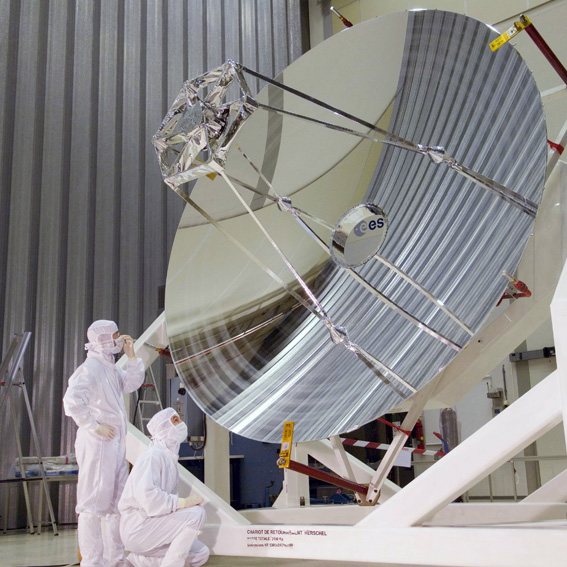
The
European Space Agency’s Herschel Space Observatory (formerly called Far Infrared
and Sub-millimetre Telescope or FIRST) has the largest single mirror, at
3.5-metres in diameter, ever built for a space telescope. It is an infrared
telescope, named after Sir William Herschel, the discoverer of the infrared
spectrum.
The
telescope has been giving astronomers an unprecedented look inside the cosmic
womb of stars, known as molecular clouds, to find (surprise, surprise) that
stars are formed in “an incredible network of filamentary structures, and
features indicating a chain of near-simultaneous star-formation events,
glittering like strings of pearls deep in our Galaxy.” Although described as
“incredible” by astronomers, this description precisely matches the decades-old
expectations of plasma cosmologists!
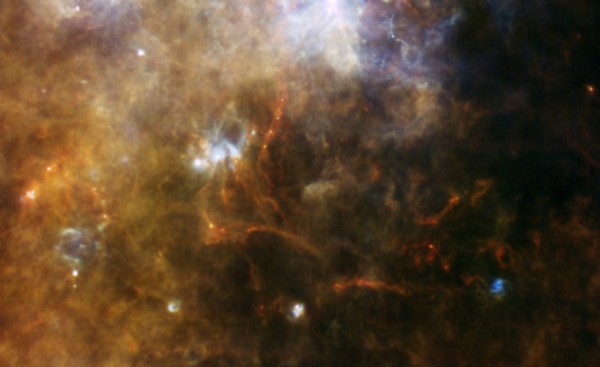
“An
incredible network of filamentary structures” seen in a cloud of cold gas in
the constellation of the Southern Cross. The ESA report dated 2 October 2009.
“That a dark, cool area such as this would be bustling with activity, was
unexpected. But the images reveal a surprising amount of turmoil: the
interstellar material is condensing into continuous and interconnected
filaments glowing from the light emitted by new-born stars at various stages of
development.”
[2009 ESA report]
In an ESA report last month the high-resolution of the Herschel space observatory produced another surprise:
“The filaments are huge, stretching for tens of light years through space and Herschel has shown that newly-born stars are often found in the densest parts of them… Such filaments in interstellar clouds have been glimpsed before by other infrared satellites, but they have never been seen clearly enough to have their widths measured. Now, Herschel has shown that, regardless of the length or density of a filament, the width is always roughly the same.
“This is a very big surprise,” says Doris Arzoumanian, Laboratoire AIM Paris-Saclay, CEA/IRFU, the lead author on the paper describing this work. Together with Philippe André from the same institute and other colleagues, she analysed 90 filaments and found they were all about 0.3 light years across, or about 20,000 times the distance of Earth from the Sun. This consistency of the widths demands an explanation.”
[Emphasis added]
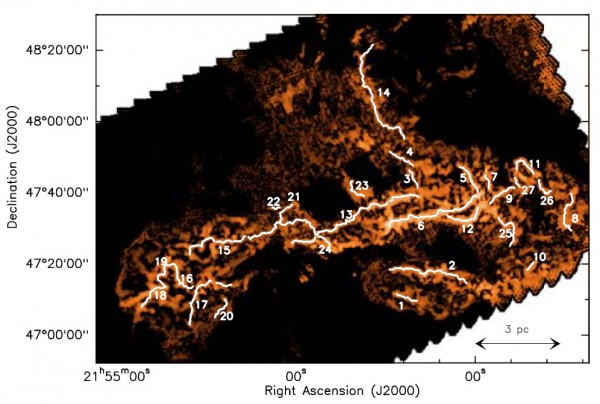
This
diagram shows a network of 27 star forming filaments derived from Herschel
observations of the IC 5146 molecular cloud. Credit: Adapted from
Characterizing interstellar filaments with Herschel in IC 5146, D. Arzoumanian
et al., A&A 529, L6 (2011).
So what is the favored conventional explanation? What else but “sonic booms” generated by “exploding stars!” But where are these exploding stars? And explosions should impose some degree of radial curvature on these filaments. But what we see is more like the tortuous paths of cloud-to-cloud lightning bolts. For that is what they are, in fact, on a cosmic scale.
The ‘father’ of plasma cosmology, Hannes Alfvén, wrote in 1986:
“That parallel currents attract each other was known already at the times of Ampere. It is easy to understand that in a plasma, currents should have a tendency to collect to filaments. In 1934, it was explicitly stated by Bennett that this should lead to the formation of a pinch. The problem which led him to the discovery was that the magnetic storm producing medium (solar wind with present terminology) was not flowing out uniformly from the Sun. Hence, it was a problem in cosmic physics which led to the introduction of the pinch effect…
However, to most astrophysicists it is an unknown phenomenon. Indeed, important fields of research, e.g., the treatment of the state in interstellar regions, including the formation of stars, are still based on a neglect of Bennett’s discovery more than half a century ago… present-day students in astrophysics hear nothing about it.”
[Emphasis added]
The constant width over vast distances is due to the current flowing along the Birkeland filaments, each filament constituting a part of a larger electric circuit. And in a circuit the current must be the same in the whole filament although the current density can vary in the filament due to the electromagnetic pinch effect. Therefore the electromagnetic scavenging effect on matter from the molecular cloud, called Marklund convection, is constant along each current filament, which simply explains the consistency of widths of the filaments. The stars form as plasmoids in the Bennett-pinches, also known in plasma labs on Earth as Z-pinches.
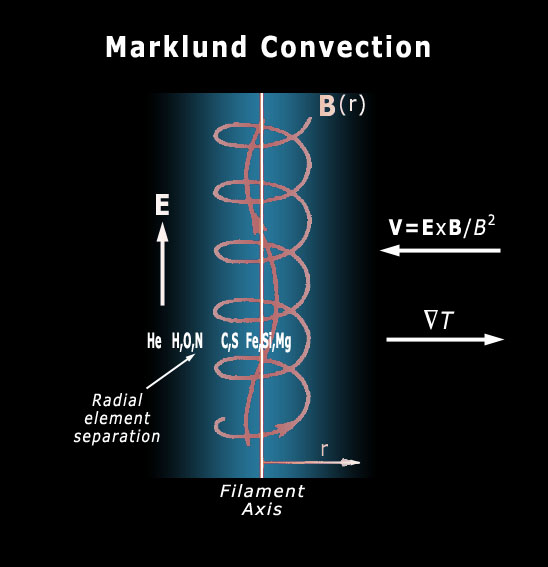
This
diagram shows the true nature of the filaments inside the molecular cloud. The
electric field vector (E) and helical magnetic field configuration (B) are
shown. Inward Marklund convection of ions at velocity, V, across a temperature
gradient, ∇T, is a mechanism for rapid filament formation and
chemical separation in cosmic plasma so the heavy elements (“metals” in
astrophysics-speak) are found on-axis and must therefore constitute the core
matter of stars, not hydrogen!
“impossible star in the act of formation… This is because the fierce light emitted by such large stars should blast away their birth clouds before any more mass can accumulate. But somehow they do form. Many of these ‘impossible’ stars are already known, some containing up to 150 solar masses, but now that Herschel has seen one near the beginning of its life, astronomers can use the data to investigate how it is defying their theories.”
The answer is simple. Astrophysicists’ theories bear no relation to reality. The luminosity of a star is not related to its massiveness because no nuclear fusion is taking place in its heavy element core. And the massiveness of a star is not related to its size because the photosphere is not a surface in the usual sense but rather an electric discharge phenomenon some distance above the surface of the star. There are no “impossible stars.”
The light of a star comes from the available electrical energy coursing along the enveloping Birkeland filaments. As for “sonic booms” caused by the pressure of light from the star, that force is negligible compared to the electromagnetic forces in the enveloping plasma. And any such collision would serve to further ionise the dust and gas and make it more susceptible to the electromagnetic force. However, if any reservation remains about the electrical environment of the Sun (and therefore all stars) then the following report should dispel that doubt.
Alfvén’s Solar Circuit Confirmed
Cosmic rays crashing into the Earth over the South Pole appear to be coming from particular locations, rather than being distributed uniformly across the sky. Similar cosmic ray “hotspots” have been seen in the northern skies too, yet we know of no source close enough to produce this pattern.
“We don’t know where they are coming from,” says Stefan Westerhoff of the University of Wisconsin-Madison. Westerhoff and colleagues used the IceCube neutrino observatory at the South Pole to create the most comprehensive map to date of the arrival direction of cosmic rays in the southern skies.
IceCube
uses neutrino detectors buried at the South Pole. IceCube detects muons produced
by neutrinos striking ice, but it also detects muons created by cosmic rays
hitting Earth’s atmosphere. These cosmic ray muons can be used to figure out
the direction of the original cosmic ray particle. (Image: NSF/B Gudbjartsson).
Between May 2009 and May 2010, IceCube detected 32 billion cosmic-ray muons, with a median energy of about 20 teraelectronvolts (TeV). These muons revealed, with extremely high statistical significance, a southern sky with some regions of excess cosmic rays (“hotspots”) and others with a deficit of cosmic rays (“cold” spots).
Over the past two years, a similar pattern has been seen over the northern skies by the Milagro observatory in Los Alamos, New Mexico, and the Tibet Air Shower array in Yangbajain. “It is interesting that the pattern can be matched between [these experiments], at least qualitatively. They have very different techniques and systematic effects,” says cosmic-ray physicist Paul Sommers at Pennsylvania State University in University Park. “I regard those hotspots as a good mystery.”
It’s a mystery because the hotspots must be produced within about 0.03 light years of Earth. Further out, galactic magnetic fields should deflect the particles so much that the hotspots would be smeared out across the sky. But no such sources are known to exist.
In the 1920s Irving Langmuir and Harold Mott-Smith showed that in a discharge tube the plasma sets up a thin boundary sheath which separates it from a wall or from a probe and shields it from the electric field. The electric field in this sheath, or ‘double layer’ of separated charge, accelerates charged particles. In 1958 Alfvén suggested that this phenomenon might be important in space plasmas. Sources of cosmic rays situated along the Sun’s axes were predicted by Alfvén in 1986 in an IEEE publication and NASA Conference Publication 2469, “Double Layers in Astrophysics.” [Warning: 13 Mb pdf file]. He explains:
“Since the time of Langmuir, we know that a double layer is a plasma formation by which a plasma — in the physical meaning of this word — protects itself from the environment. It is analogous to a cell wall by which a plasma — in the biological meaning of this word — protects itself from the environment. If an electric discharge is produced between a cathode and an anode there is a double layer, called a cathode sheath, produced near the cathode that accelerates electrons which carry a current through the plasma. A positive space charge separates the cathode sheath from the plasma. Similarly, a double layer is set up near the anode, protecting the plasma from this electrode. Again, a space charge constitutes the border between the double layer and the plasma. All these double layers carry electric currents.”
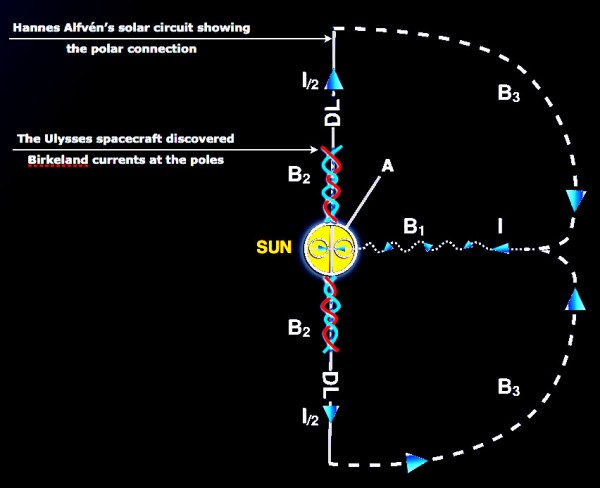
Alfvén’s
Heliospheric Circuit. The Sun acts as a unipolar inductor (A) producing a
current which goes outward along both the axes (B2) and inward in the
equatorial plane along the magnetic field lines (B1). The current must close at
large distances (B3), either as a homogeneous current layer, or — more likely —
as a pinched current. Analogous to the auroral circuit, there may be double
layers (DLs) which should be located symmetrically on the Sun’s axes. Such
double layers have not yet been discovered. Credit: Original diagram by H.
Alfvén, NASA Conference Publication 2469, 1986, p. 27.
Because of their property of generating cosmic rays, synchrotron radiation, radio noise, and occasionally exploding, Alfvén proposed, “DL’s may be considered as a new class of celestial objects… For example, the heliospheric current system must close at large distances, and it is possible — perhaps likely — that this is done by a network of filamentary currents. Many such filaments may produce DL’s, and some of these may explode.” To give an idea of their omnipresence in space, DLs are implicated in the earth’s auroral regions, extragalactic jets, stellar jets, novae and supernovae, X-ray and gamma-ray bursts, X-ray pulsars, double radio sources, solar flares, and the source of cosmic ray acceleration.
It seems that Alfvén’s DLs have been detected in the form of “cosmic ray hotspots” generated in Birkeland current filaments “less than 0.03 light years” from the Sun. The hotspots should be found to align with the local interstellar magnetic field. The median energy of the cosmic rays reported at 20 TeV is within the range expected from a cosmic DL.
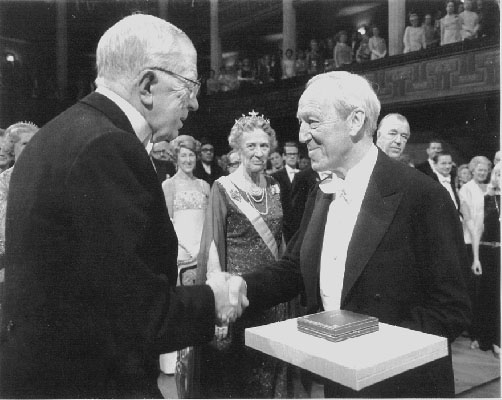
And a final word from Alfvén, who took the unprecedented step of predicting in his December 11, 1970 Nobel prize acceptance speech the eventual crash of astrophysics at the end of its long dark tunnel:
“In conclusion, it seems that astrophysics is too important to be left in the hands of theoretical astrophysicists who have gotten their education from the listed textbooks. The multibillion dollar space data from astronomical telescopes should be treated by scientists who are familiar with laboratory and magnetospheric physics, circuit theory, and, of course, modern plasma physics. More than 99 percent of the Universe consists of plasma, and the ratio between electromagnetic and gravitational forces is 1039.”
—H. Alfvén, NASA Conference Publication 2469, 1986, p. 16.
From Electric Universe @ http://www.holoscience.com/wp/alfven-triumphs-again-again/
And see A
New Vision Emerges At Last: Science’s Looming ‘Tipping Point’ by Wal
Thornhill
For more information about our electric universe see http://nexusilluminati.blogspot.com/search/label/electric%20universe
- Scroll down through ‘Older Posts’ at the end of each section
Hope you like this
not for profit site -
It takes hours of work every day by
a genuinely incapacitated invalid to maintain, write, edit, research,
illustrate and publish this website from a tiny cabin in a remote forest
Like what we do? Please give anything
you can -
Contribute any amount and receive at
least one New Illuminati eBook!
(You can use a card
securely if you don’t use Paypal)
Please click below -
Xtra Image by R. Ayana – https://farm9.staticflickr.com/8212/8304150292_63c96eaa6c_b.jpg
For further enlightening
information enter a word or phrase into the random synchronistic search box @
the top left of http://nexusilluminati.blogspot.com
And see
New Illuminati – http://nexusilluminati.blogspot.com
New Illuminati on Facebook - https://www.facebook.com/the.new.illuminati
New Illuminati Youtube Channel - http://www.youtube.com/user/newilluminati/feed
New Illuminati on Google+ @ https://plus.google.com/115562482213600937809/posts
New Illuminati on Twitter @ www.twitter.com/new_illuminati
New Illuminations –Art(icles) by
R. Ayana @ http://newilluminations.blogspot.com
The Her(m)etic Hermit - http://hermetic.blog.com
The Prince of Centraxis - http://centraxis.blogspot.com (Be
Aware! This link leads to implicate & xplicit concepts & images!)
DISGRUNTLED SITE ADMINS PLEASE NOTE –
We provide a live link to your original material on your site (and
links via social networking services) - which raises your ranking on search
engines and helps spread your info further! This site is
published under Creative Commons Fair Use Copyright (unless an individual
article or other item is declared otherwise by the copyright holder). Reproduction
for non-profit use is permitted & encouraged, - if you give attribution to the work &
author. Please include a (preferably active) link to the original (along with
this or a similar notice).
Feel free to make non-commercial hard (printed) or software copies or
mirror sites - you never know how long something will stay glued to the web –
but remember attribution!
If you like what you see, please send a donation (no amount is too
small or too large) or leave a comment – and thanks for reading this far…
Live long and prosper! Together we can create the best of all possible
worlds…
From the New Illuminati – http://nexusilluminati.blogspot.com
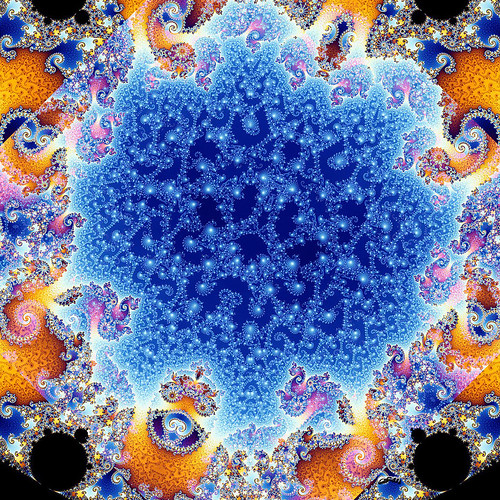
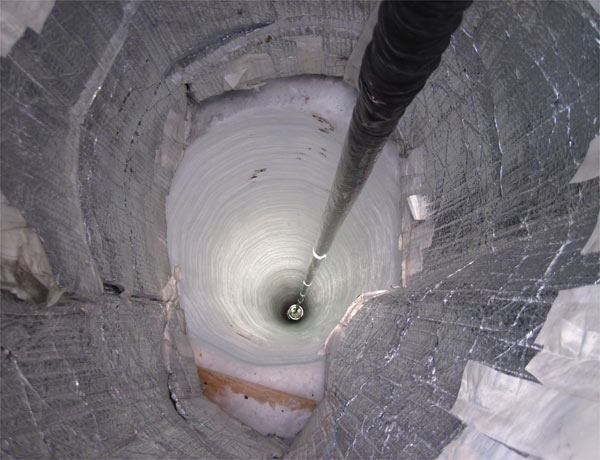
No comments:
Post a Comment
Add your perspective to the conscious collective